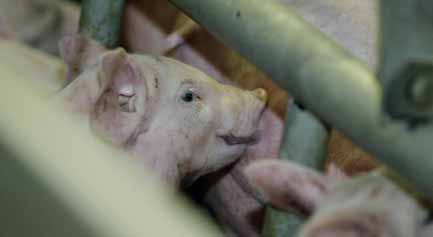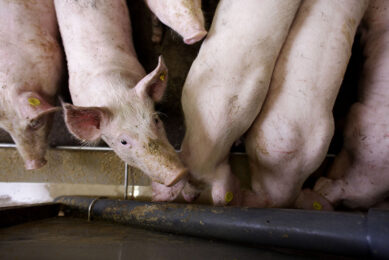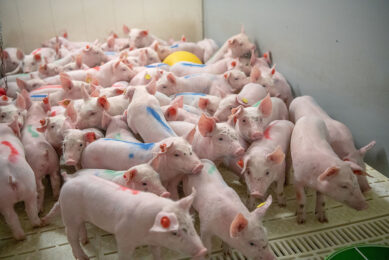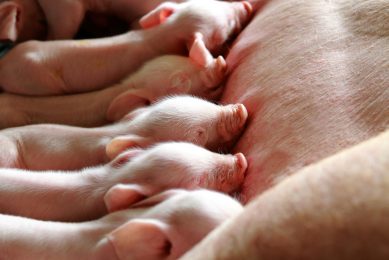How trace minerals can help achieve 35 piglets/sow/year

Trace minerals have a major impact at all stages of reproduction. It is essential to provide trace minerals at the correct quantity and form to the modern hyper-prolific sow. This will help to achieve the target of weaning 35 piglets per year, to reduce premature culling, to enhance sow lifetime performance and to increase piglet weaning weight.
One of the major achievements in pig production in the past decade has been the considerable improvement in sow reproductive performance. Indeed, in several countries it is not uncommon to wean 30-35 piglets per sow per year. This has been achieved through genetic selection for hyperprolificacy as well as a better understanding of the biology of the pig, including its nutrient requirements and the development of appropriate feeding strategies to meet these nutrient needs. Much attention has been directed towards a better understanding of the energy and amino acid needs, but less so on the mineral and vitamin requirements. This paper will discuss the mineral nutrition of the modern hyper-prolific sow, with special emphasis on the trace elements.
Mineral requirements
Minerals are essential for the normal functioning of the body and to ensure optimum productivity and health. Estimates of mineral needs are provided in Table 1 .
While the role of macro elements such as calcium (Ca), phosphorus (P) and magnesium (Mg) have been well defined, that of the trace minerals for the modern sow is less so. In addition, much of the work on such estimates were based on trials that were carried out pre-1990, when sow performance was considerably less than that of today’s modern animal. This raises the question about the relevance of such recommendations for the modern sow producing 35 piglets per sow per year.
Indeed, Mahan and Newton (1995) show the considerable mineral mobilisation which occurs in sows at the end of their third parity, when compared with non-bred litter sisters of similar age and when fed diets according to the NRC standards. In addition, the higher the litter weaning weight, the greater the rate of sow mineral depletion. It can also be calculated that on a body weight basis, at similar mineral levels in the feed, there is a 15-20% reduction in the mineral intake between the first and third parity. This reduced mineral intake and body status of the sow may result in premature culling.There is also concern about the form of minerals provided in the diet and their availability to the animal. Inorganic minerals may form complexes that are difficult to absorb. In addition, inorganic minerals can interfere with each other and, when provided in excess, may reduce absorption of others. For this reason, there is interest in organic minerals, such as proteinated or chelated minerals, e.g. iron (Fe), zinc (Zn), copper (Cu), and manganese (Mn), as well as minerals in yeast form, like selenium (Se), chromium (Cr). Organic minerals are more bio-available and confer a metabolic advantage to the animal which often results in improved productivity.
Mineral provision
The provision of organic minerals such as Fe and Se have been shown to considerably influence the mineral status of the sow and her piglets, as well as colostrum and milk production, with consequential effects on performance.
For example, Close and Taylor-Pickard have shown that when organic Fe (Bioplex) was provided in the diet of the sow in both gestation and lactation, pre-weaning mortality was reduced from 10.8 to 6.8% and piglet weaning weight increased by 0.31 kg, from 6.17 to 6.48 kg. Similarly, Taylor-Pickard and Close show that when organic Se (Sel-Plex) replaced sodium selenite in the diet of the sow at the same level, pre-weaning mortality of piglets was reduced by 20%, from 14.5% to 11.6%. As a consequence, those sows fed the Se yeast weaned 0.27 more piglets per litter. These studies therefore demonstrate that providing minerals in organic rather than the inorganic form elicit superior performance in both sows and piglets. One of the consequences of larger litters is greater within-litter variation in piglet weight, as well as an overall decrease in birth weight.
In general, each extra piglet born reduces mean birth weight by about 40 g and there is an increase in the proportion of light/ vulnerable piglets. Unfortunately, colostrum production by the sow does not follow litter size, with the result that colostrum intake per piglet is reduced, and this is further exacerbated by the lower birth weight of a greater proportion of light weight piglets in the litter. The glycogen, mineral and vitamin reserves of the piglet may also suffer. As a consequence of this reduced colostrum intake, as well as poorer quality piglets at birth, immunity and growth rate is reduced and pre-weaning mortality is significantly increased. The total replacement of inorganic with organic minerals in the diet of the sow may therefore benefit the piglet and ensure better quality at birth with enhanced suckling stimulus, better colostrum intake with higher survivability and a heavier body weight at weaning.
Impact on performance
It is recognised that trace minerals impact at all stages of reproduction in the sow: Ovulation rate, fertilisation rate, and embryo and litter survivability. To ensure good reproduction it is necessary to maintain and protect tissue integrity and function against reactive oxygen species (ROS) and free radicals. Providing adequate levels of antioxidants in the diet, such as Se and Vitamin E, will safeguard the survival and quality of oocytes and follicles fundamental to good ovulation rate and embryo survival.
The importance of the form of Se in ensuring good embryo development has been investigated by Fortier and others, earlier this year. Gilts were fed either a control diet with no added Se or diets with an additional 0.3 ppm Se from either inorganic or organic selenium (sodium selenite or selenium yeast) up to day 30 of gestation.
Interestingly, those gilts fed the diet containing organic Se had a greater number of living embryos than those fed inorganic Se, and the length, weight and protein content of the embryos was significantly greater (p<0.05) (see Table 2 ). The Se content of the embryos from gilts fed organic Se was almost double that from gilts fed inorganic Se; this is in keeping with several other studies of neonatal pigs. It is interesting to note that there was little difference in response between the control gilts and those fed inorganic Se for many of the parameters tested.
These results therefore indicate that dietary organic Se may be critical for an efficient Se transfer to embryos and for their subsequent development in early gestation.Different minerals impact at different periods of the reproductive life of the sow and it is likely that the greatest impact on sow productivity will be from combinations of minerals. An interesting study has been reported by Peters and Mahan where they compared the performance of sows fed diets containing either inorganic (sulphates and sodium selenite) or organic trace minerals at NRC or industry levels to sows over six parities. Sows fed organic trace minerals produced more piglets per litter (p<0.05) compared with sows fed inorganic minerals: 12.2 vs. 11.3 total born and 11.3 vs. 10.6 born alive, respectively. Performance was highest when the diets were supplemented with organic minerals at industry compared with NRC levels. Reduced reproductive performance appeared to be exacerbated when the gestation diet contained higher dietary levels of calcium (Ca) and phosphorus (P) than those recommended by NRC (1998).
They concluded that feeding sows organic trace minerals may improve sow reproductive performance, but there were minimal effects on other reproductive measurements. This is in contrast to the study of Papadopoulos and others (2009) which concluded that partial substitution of inorganic minerals with a chelated mineral source failed to exert a significant effect on performance and total body mineral concentration. However, the form of the minerals in that study was different and they were only provided during late gestation and lactation.
Conclusions
Trace minerals have a major impact at all stages of reproduction. The provision of trace minerals at the correct level and form are essential for sows to achieve the target of weaning 35 piglets per year, to reduce premature culling and to enhance sow lifetime performance. The quality of the piglet at birth and weaning is increased and this helps to reduce pre-weaning mortality and to increase piglet weaning weight. Variation in the weight of piglets at weaning is reduced and this facilitates management. On-going research will better define the optimum organic mineral requirement to meet the metabolic needs of sows to ensure the target of 35 piglets weaned per sow per year is achieved on many farms. PP











